
Nurses and tech workers formed a picket line Wednesday outside Alta Bates Summit Medical Center in Oakland to protest cuts by Sutter Health to worker benefits and in-patient care services. Photos by Luke Thomas.
June 14, 2012
For the fourth time since September, nurses across nine Sutter Health hospitals went on strike Wednesday in response to management demands for worker concessions that include reductions in healthcare coverage, increased pension contributions and changes to workplace rights and conditions.
The nurses are also protesting widespread cuts by Sutter to in-patient care services.
According to Sutter Health’s website on labor issues, just under half of all nurses at their California hospitals joined picket lines, with 55 percent of nurses opting to “cross over,” meaning they reported to work as usual. The strike affects some 4,400 nurses across eight northern California hospitals.
Holding fast in negotiations, the nurses are protesting Sutter Health’s efforts to reduce paid vacation time by two weeks, requiring nurses to pay more into their pension plans, removing nurse stipends for educational leave, as well as reductions to benefits and pay they say are out of control.
Sutter Health, a nonprofit organization, counters its nurses earn on average $136,000 a year, enjoy up to eight weeks paid time off for sick leave and vacations each year, and that they have robust pension plans totaling as much as $84,000 a year in combined pay and benefits, costs Sutter says it can no longer afford.
The California Nurses Association (CNA), the union leading the strike, refutes those claims.
“Nurses on average make a little over $100,000 a year,” registered nurse Mike Hill told Fog City Journal. Mr. Hill is a night nurse, working graveyard shifts at the intensive care unit at Alta Bates hospital in Oakland where he’s worked since 1986.
Hill said nurses usually start out with four weeks of paid vacation, and one day of sick leave per month, and that sick time can roll over. The claims made by Sutter are a distortion, he said.
Sutter Health repeatedly cites inaccurate numbers, he said. When CNA asked Sutter for worker W2’s to back up their claims, Sutter would not produce the documents.
“Half the time they send us something and the numbers don’t add up,” Hill said. For the past year he’s been at the negotiating table as a rep for CNA, arguing to simply renew the contract that nurses have with the hospitals.
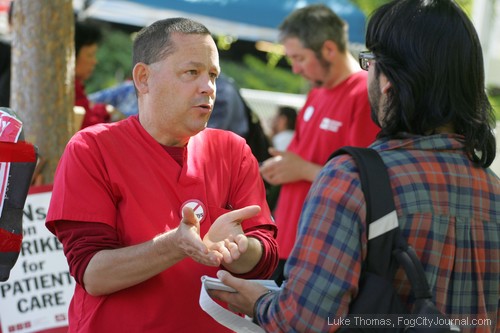
Registered nurse and CNA negotiations rep, Mile Hill, discusses the picket and protest with Fog City Journal.
Sutter sees the situation differently. According to Sutter Health, rising healthcare costs require changes in wages and benefits for the non-profit to remain competitive. Conversely, Sutter also claims nurses are misrepresenting the issue.
“Frustrated with a lack of success in attracting new members through traditional organizing approaches, many labor organizations across the nation engage in negative campaigns of misinformation against employers. Such campaigns are intended to disparage the reputation of an employer with the goal of forcing an organization to agree to specific union contract demands,” Sutter says on their contract negotiation website.
Alta Bates Regional Manager of Public Relations Carolyn Kemp says unions are losing steam. The 55 percent “crossover” rate of nurses who opted not to strike is indicative of the union’s loss of power, she said.
And the nurses that did choose to strike? “They chose not to be here, caring for their patients,” Kemp told Fog City Journal.
Inadequate care
Nurses like Luciell Rilay said Alta Bates in Oakland, a Sutter Health-owned hospital where she works the night shift in the ICU, is not providing enough staff to provide adequate care in the first place.
Rilay said there are often no certified nursing assistants on night shifts, fewer transporters than they need to move patients from ER to the ICU, and no social workers in a hospital that serves Oakland’s most vulnerable population.
Those of Oakland’s working class and poor already have bad home situations, “as we all do, really,” Rilay said.
“These are the worst situations of their lives,” Rilay added. “You throw in impending death, and you have Jerry Springer in there.”
Staffing levels are determined by a complex formula, Kemp said. When asked if Sutter Health had proper staffing levels, she said that it varies so often from night to night that giving a broad answer would be hard to determine.
Hill said reduced staffing levels are just one out of many examples of Sutter Health funneling the savings to the top and not using its profits to provide adequate care to patients in its chain of hospitals.
Sutter is determined to continue that bounty by squeezing nurses, Hill said.
Sutter Health has made over $4.2 billion in profits since 2005, according to CNA.
“We’re telling you from exact experience. We run out of supplies. It takes longer to get the room cleaned; it takes longer to get things done at the hospital. A nurse can’t give great customer care when they can’t get the supplies they need. When someone needs a sleeping pill at nine and can’t get it by one a.m., there’s a problem there,” Hill said.
Patient death looms
The strike took place in the shadow of the death of patient Judith Ming, who was killed when a nurse at Alta Bates put a nutritional supplement tube into a catheter meant for Ming’s bloodstream. The nurse responsible was a replacement nurse called into Alta Bates during a strike by the CNA back in September last year.
When asked if nurses feared another mistake while they were away from their jobs, Hill said that it was true that its difficult for replacement nurses to learn the ropes of a new hospital in a single day. Changes in methodology, technology and routines all add up to a dangerous situation for patients.
Kemp refuted those claims. “That’s a scare tactic,” she said. “Eighty-three percent of the nurses to replace strikers have been here before,” Kemp said.
The risk of using replacement nurses is exacerbated by Sutter’s policy of “locking out” striking nurses for four to five days after the strike, a punitive measure that deprives strikers a week’s worth of pay. It was during a similar lockout that Ms. Ming, 66, lost her life.
More protest photos
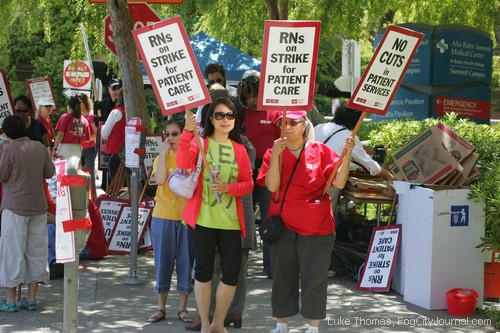
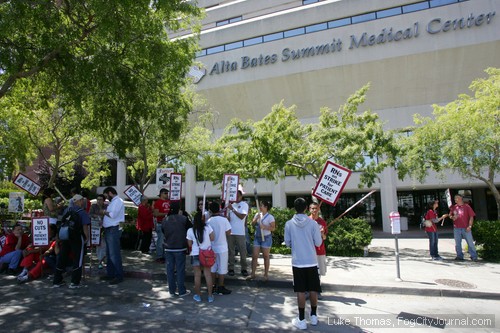
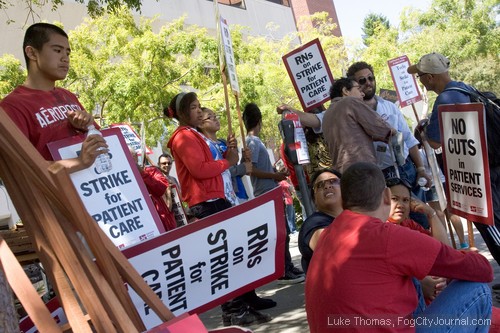
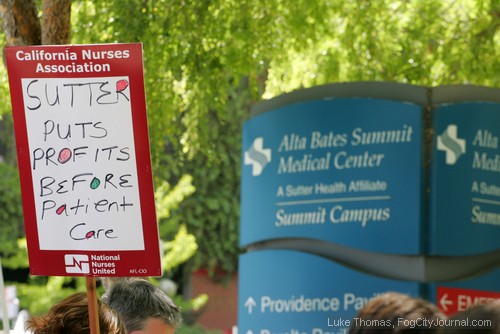
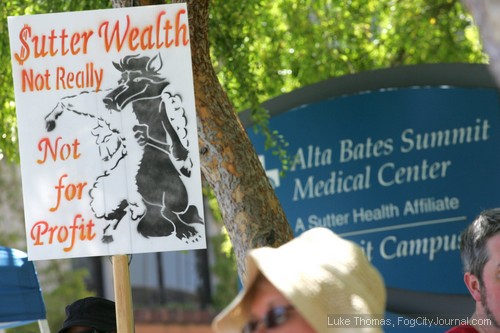



 The Hunger Site
The Hunger Site
June 24, 2012 at 10:58 pm
“Sutter’s policy of “locking out” striking nurses for four to five days after the strike”
– The Union agreed to this. The reason for this is because when nursing strikes happen, the nurses need to be replaced, possibly by people who live far from the area. They’ll need to be flown in, and they wont work for just one day. Hence Sutter and the Union BOTH agreed to this policy.
Not sure if I completely agree with the Nursing strike. Even without Sutter Health figures, the average RN in California alone is way over the national RN average. http://www.bls.gov/oes/current/oes291111.htm
Scroll down to Annual Mean Wage of RN in 2011, the purple map. Please tell me where ALL of the top 10 highest annual mean wages for RN’s are. I highly doubt Sutter would be paying below the mean.
June 18, 2012 at 8:53 am
I am so proud of my Union, possibly the most active, effective and relevant of them all. As a former Sutter employee I can attest to how ‘bad’ they are.
June 14, 2012 at 2:11 pm
If you judge someone not by their words but by their actions, there is much to worry about with respect to Sutter Health.
Sutter Health, a non profit that acts like a for profit corporation has the lowest level of charity of spending of any healthcare provider in the state, has been hostile to labor and in general, operates with a disrespect for the needs of the community.
Sutter Health, via CPMC is currently trying to force an over sized hospital in my neighborhood – taller and wider than planning codes allow, one that displaces housing, while fighting the city in terms of a community benefits agreement. What they are offering is very little.
They also continue to deny labor many basic rights for this new hospital including the transfer of seniority rights if they relocate from another Sutter Health hospital in the city – St. Lukes. Other than Emergency Room admissions, they also won’t serve the community surrounding it.
Sutter Health. There is much to worry about.